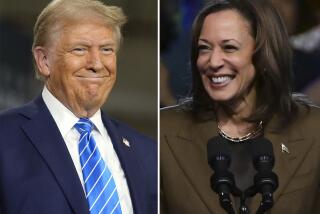Counting GOP delegates is a mind-bending game
- Share via
Reporting from Washington — According to the latest delegate count, Mitt Romney is nearly halfway to the Republican presidential nomination.
Or not.
Delegate trackers for the Republican National Committee credit the front-runner with 478 of the 1,144 delegates needed to win. That’s almost 100 fewer than the widely followed Associated Press projection.
“Romney will get to 1,144 when the RNC says you are to 1,144,” said Christian Ferry, deputy campaign manager for 2008 Republican nominee John McCain.
When that day might come is a matter of intense speculation. It’s muddled by a complex web of rules — different in each state — that fogs the crystal balls of even the most knowledgeable authorities.
“By all accounts, if things stay as they are now though the end of the primary process, then we’re probably talking about June before Romney can get to 1,144,” said Josh Putnam, a political science professor at Davidson College in North Carolina who closely follows the primary process. That would make it the longest Republican contest since 1976, when the race stretched to the convention in August.
Romney has won more than 55% of the delegates allocated to date and needs about 45% of the remaining delegates to go over the top. Rick Santorum’s extremely slim chance of becoming the nominee depends on a contested convention rejecting Romney on the first ballot and then turning to him as an alternative. That scenario, which has never materialized in the modern primary era, has become even more remote as Romney has won pivotal victories in Michigan, Ohio and, most recently, Illinois.
At this stage of the campaign, the Republican race is as much a matter of psychology as arithmetic.
“The magic number is not necessarily 1,144 in terms of delegate counts. It’s going to be when [Newt] Gingrich or Santorum decides to get out of the race,” Putnam said.
But until the race is over, Romney, the likely nominee, cannot pivot toward the general election and start patching up his party after an unusually divisive primary season.
Santorum could run “a nuisance campaign” all the way to the convention in Tampa, Fla., in late August, said Republican strategist Mike Murphy. “The problem for the party is it keeps the narrative of the campaign about division within the party, rather than focusing on ... the fall.”
Santorum, he said, faces an internal struggle: between his current image as a conviction candidate who gives voice to evangelical Christians and social conservatives in the party, and the “team player” he used to be as a member of the Republican leadership in the Senate.
“There comes a point where his campaign becomes more about helping Obama than his own principles,” said Murphy, a Romney advisor in 2008 who is nonaligned this year.
With the pace of primaries slowing, delegate numbers have become weapons as strategists for the leading contenders make cases for ending or extending the race.
“The remaining contests offer no path to 1,144 for Sen. Santorum,” wrote Rich Beeson, the Romney campaign’s political director, in a memo to reporters. Santorum advisor John Yob countered that Santorum actually had piled up more than 300 delegates already — more than any independent tally gives him — and that Romney’s lead was much smaller than others were assuming.
A fudge factor in delegate math gives Santorum’s argument some plausibility. About 1 in 5 delegates will go to the nominating convention as free agents, at least theoretically open to last-minute arguments that could shake Romney’s seeming inevitability.
Some of the unbound delegates are among the 168 party officials guaranteed votes on the convention floor. Their preferences for a particular candidate are often included in delegate counts, if they are known. A relatively small number of their Democratic counterparts, known as super-delegates, switched sides during the 2008 primary battle between Barack Obama and Hillary Rodham Clinton.
Another factor that causes variation in delegate counts involves states, like Iowa, that held caucuses but have not yet selected delegates. Delegate counters often project gains, based on nonbinding straw votes, that aren’t borne out when delegates are chosen, months later, at congressional district or statewide conventions.
There is also the reality that the national convention has the power to rewrite the rules once the delegates gather. For that reason, the count at this point in the race is “like the stats in football — the quarterback rating. It really doesn’t have a lot to do with winning or losing” the nomination, said Norm Cummings, who was the McCain campaign liaison to the party’s rules committee in 2008.
The last contested Republican convention was in 1976, when President Ford fought off Ronald Reagan’s conservative challenge. Romney’s recent successes have reduced the odds that he’ll have to spend the summer trying to prevent a repeat this year.
But if his rivals can credibly argue that the delegate score card doesn’t give him a mathematical lock on the nomination, they could take the fight all the way to Tampa.
“I still think there is the potential to have a raucous convention,” Cummings said.
More to Read
Get the L.A. Times Politics newsletter
Deeply reported insights into legislation, politics and policy from Sacramento, Washington and beyond. In your inbox twice per week.
You may occasionally receive promotional content from the Los Angeles Times.










